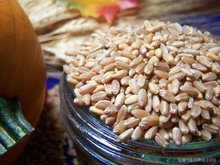Milling your own grain at home is easy. Just look at that video, took really no extra effort at all. And it's better for you!
Technorati Tags: Milling, Whole Wheat
Eating whole wheats are beneficial to your health in so many ways. They contain a lot of fiber and vitamins that are essential for good health.

Posted by
Millers Grain House
at
9:50 AM
0
comments
![]()
Labels: milling, video, whole wheat
If you have whole grains in their complete unaltered form in your house. Remember, they require special protection. As with any other food, they need to be stored properly to prevent spoiling.
Be sure to keep your grains in an air tight container in a cool room. Also be sure that the room is not humid and the container does not promote any condensation. If you don't protect the grains they will either spoil or sprout!
Once the grain is processed into a baked good, protect that goodness with a little more attention to storage. Whole grains tend to both dry out and mold faster than bleached or processed grains. You may want to store them in the refrigerator and you certainly will want to make sure they are stored in an airtight container or package.
Usually, in our home, once the grain is milled and then used, the items are not around long enough for them to spoil - we eat them too fast! To have the goodness of whole grains for a prolonged span of time, simply requires a little planning and protection.
Thanks for reading, I hope it was helpful. :)
Technorati Tags: Grains, Milling, Whole Grains
Posted by
Millers Grain House
at
2:06 PM
0
comments
![]()
Labels: storage, whole grains
 Whole grains are important for your health, but what exactly is a grain? And how do we know if it's good for you?
Whole grains are important for your health, but what exactly is a grain? And how do we know if it's good for you?
Posted by
Millers Grain House
at
7:24 AM
0
comments
![]()
Labels: bran, endosperm, germ, whole grains